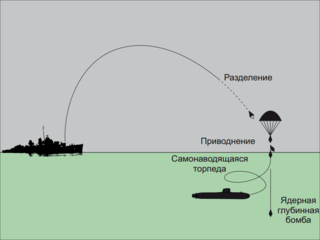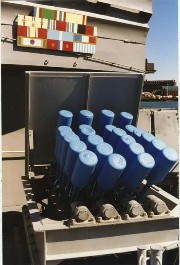
The RUR-5 ASROC is an all-weather, all sea-conditions anti-submarine missile system. Developed by the United States Navy in the 1950s, it was deployed in the 1960s, updated in the 1990s, and eventually installed on over 200 USN surface ships, specifically cruisers, destroyers, and frigates. The ASROC has been deployed on scores of warships of many other navies, including Canada, Germany, Italy, Japan, the Republic of China, Greece, Pakistan and others.

A depth charge is an anti-submarine warfare (ASW) weapon designed to destroy submarines by detonating in the water near the target and subjecting it to a destructive hydraulic shock. Most depth charges use high explosives with a fuze set to detonate the charge, typically at a specific depth from the surface. Depth charges can be dropped by ships, patrol aircraft and helicopters.

ARA San Luis (S-32) was a Type 209 diesel-powered submarine of the Argentine Navy. Built in Germany, San Luis has a displacement of 1,285 tonnes and was commissioned in 1974. The submarine operated against the Royal Navy during the Falklands War without any noticeable success, but survived a number of anti-submarine sweeps carried out by British frigates. San Luis was struck in 1997 after an incomplete overhaul; as of 2020, its hull remained stored at Domecq Garcia Shipyard (Tandanor).

The WE.177, originally styled as WE 177, and sometimes simply as WE177, was a series of tactical and strategic nuclear weapons with which the Royal Navy (RN) and the Royal Air Force (RAF) were equipped. It was the primary air-dropped nuclear weapon in the United Kingdom from the late 1960s into the 1990s.

The RPK-2 Vyuga, also designated as 81R, is a Soviet submarine-launched, nuclear-armed anti-submarine missile system, launched exclusively through 533-millimetre (21.0 in) torpedo tubes. The system was designed in Sverdlovsk, Russian SFSR in the 1960s.

The Ikara missile was an Australian ship-launched anti-submarine missile, named after an Australian Aboriginal word for "throwing stick". It launched an acoustic torpedo to a range of 10 nautical miles (19 km), allowing fast-reaction attacks against submarines at ranges that would otherwise require the launching ship to close for attack, placing itself at risk. By flying to a distant target, the engagement time was dramatically shorter than provided by short-range weapons, giving the target less time to respond.

USS Bluefish (SSN-675), a Sturgeon-class attack submarine, was the second ship of the United States Navy to be named for the bluefish.

The B57 nuclear bomb was a tactical nuclear weapon developed by the United States during the Cold War.

An anti-submarine weapon (ASW) is any one of a number of devices that are intended to act against a submarine and its crew, to destroy (sink) the vessel or reduce its capability as a weapon of war. In its simplest sense, an anti-submarine weapon is usually a projectile, missile or bomb that is optimized to destroy submarines.

The Mark 45 anti-submarine torpedo, a.k.a. ASTOR, was a submarine-launched wire-guided nuclear torpedo designed by the United States Navy for use against high-speed, deep-diving, enemy submarines. This was one of several weapons recommended for implementation by Project Nobska, a 1956 summer study on submarine warfare. The 19-inch (480 mm)-diameter torpedo was fitted with a W34 nuclear warhead. The need to maintain direct control over the warhead meant that a wire connection had to be maintained between the torpedo and submarine until detonation. Wire guidance systems were piggybacked onto this cable, and the torpedo had no homing capability. The design was completed in 1960, and 600 torpedoes were built between 1963 and 1976, when ASTOR was replaced by the Mark 48 torpedo.
Anti-submarine mortars are artillery pieces deployed on ships for the purpose of sinking submarines by a direct hit with a small explosive charge. They are often larger versions of the mortar used by infantry and fire a projectile in relatively the same manner. They were created during World War II as a development of the depth charge and work on the same principle.

The UUM-125 Sea Lance, known early in development as the Common ASW Standoff Weapon, was to be an American standoff anti-submarine missile, initially intended to carry a W89 thermonuclear warhead. It was conceived in 1980 as a successor to both the UUM-44 SUBROC and RUR-5 ASROC anti-submarine missiles. The Sea Lance was to be available in two versions, known as UUM-125A and RUM-125A. The former would be a submarine-launched version, the latter surface-launched. It was cancelled in 1990 as its importance was obviated by the collapse of the Soviet Union.

Anti-submarine warfare is a branch of underwater warfare that uses surface warships, aircraft, submarines, or other platforms, to find, track, and deter, damage, or destroy enemy submarines. Such operations are typically carried out to protect friendly shipping and coastal facilities from submarine attacks and to overcome blockades.
According to researcher Chuck Hansen, the W34 Python was a gas-boosted fission primary used in several designs of American thermonuclear weapons.
The W34 was an American nuclear bomb developed and deployed during the mid-1960s.

The Mark 101 Lulu was an airdropped nuclear depth charge developed by the United States Navy and the Atomic Energy Commission during the 1950s. It carried a W34 nuclear warhead, with an explosive yield of about 11 kilotons. It was deployed by the U.S. Navy for the purposes of antisubmarine warfare, in at least five different models, from 1958 through 1971. These nuclear weapons were also stockpiled overseas at the bases of NATO allies, under American military guard and control, for the potential use by maritime patrol planes of NATO. Thus was most notable at the air base of RAF St. Mawgan in Cornwall, for potential use by British Avro Shackleton patrol planes and the Royal Netherlands Navy's P-2 Neptune and P-3 Orion patrol planes. Neither the Lulu nor any other kind of nuclear antisubmarine or antiship weapon was ever used in combat by any country.

An anti-submarine missile is a standoff anti-submarine weapon. Often a variant of anti-ship missile designs, an anti-submarine systems typically use a jet or rocket engine, to deliver an explosive warhead aimed directly at a submarine, a depth charge, or a homing torpedo that is carried from a launch ship, or other platform, to the vicinity of a target.

The UUM-44 SUBROC was a type of submarine-launched rocket deployed by the United States Navy as an anti-submarine weapon. It carried a 250 kiloton thermonuclear warhead configured as a nuclear depth bomb.
A nuclear torpedo is a torpedo armed with a nuclear warhead. The idea behind the nuclear warheads in a torpedo was to create a much bigger explosive blast. Later analysis suggested that smaller, more accurate, and faster torpedoes were more efficient and effective.

SMART is a canister-based, long-range anti-submarine missile developed by the Defence Research and Development Organisation (DRDO) for the Indian Navy.
















